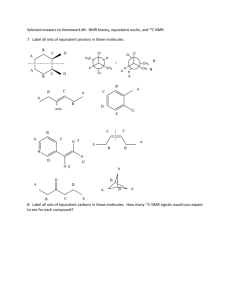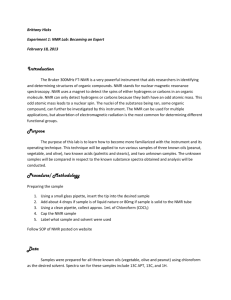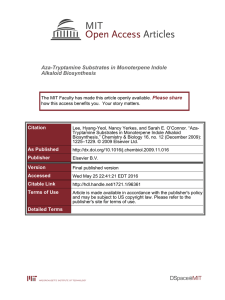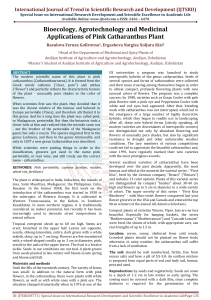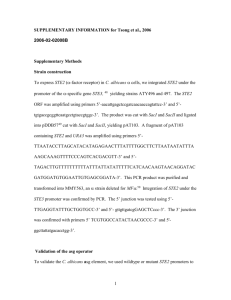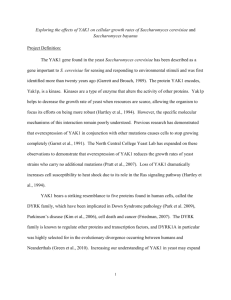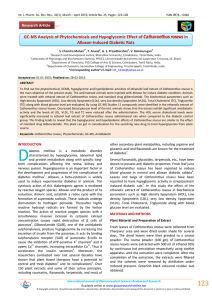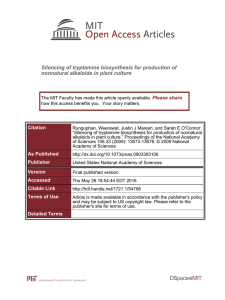file - BioMed Central
advertisement
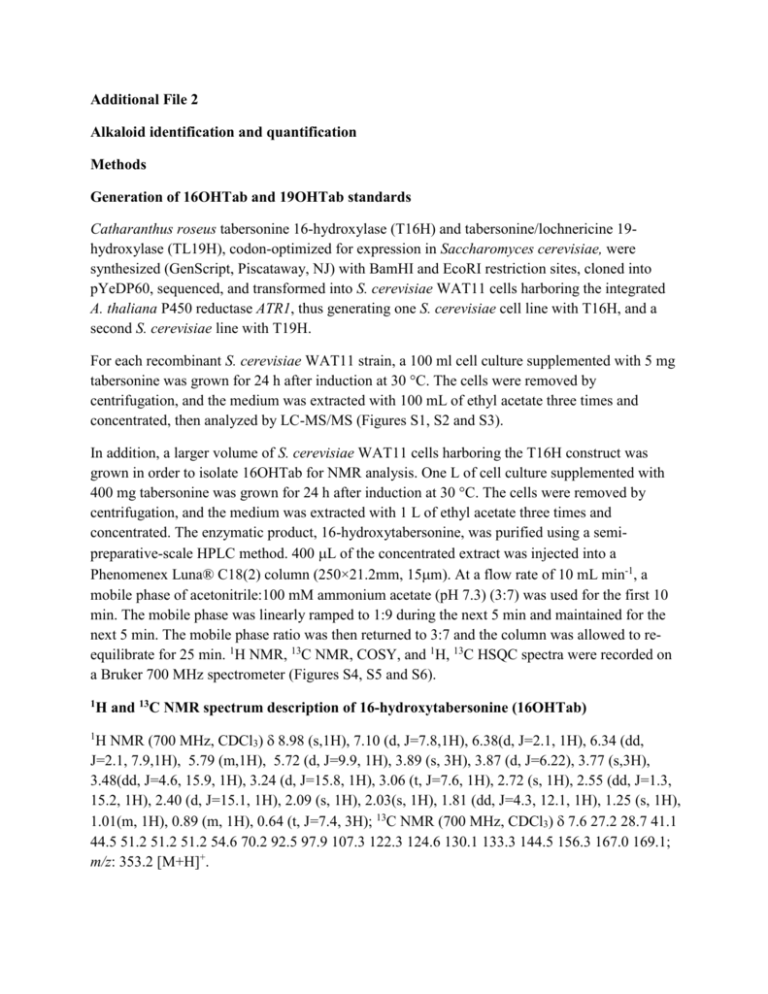
Additional File 2 Alkaloid identification and quantification Methods Generation of 16OHTab and 19OHTab standards Catharanthus roseus tabersonine 16-hydroxylase (T16H) and tabersonine/lochnericine 19hydroxylase (TL19H), codon-optimized for expression in Saccharomyces cerevisiae, were synthesized (GenScript, Piscataway, NJ) with BamHI and EcoRI restriction sites, cloned into pYeDP60, sequenced, and transformed into S. cerevisiae WAT11 cells harboring the integrated A. thaliana P450 reductase ATR1, thus generating one S. cerevisiae cell line with T16H, and a second S. cerevisiae line with T19H. For each recombinant S. cerevisiae WAT11 strain, a 100 ml cell culture supplemented with 5 mg tabersonine was grown for 24 h after induction at 30 °C. The cells were removed by centrifugation, and the medium was extracted with 100 mL of ethyl acetate three times and concentrated, then analyzed by LC-MS/MS (Figures S1, S2 and S3). In addition, a larger volume of S. cerevisiae WAT11 cells harboring the T16H construct was grown in order to isolate 16OHTab for NMR analysis. One L of cell culture supplemented with 400 mg tabersonine was grown for 24 h after induction at 30 °C. The cells were removed by centrifugation, and the medium was extracted with 1 L of ethyl acetate three times and concentrated. The enzymatic product, 16-hydroxytabersonine, was purified using a semipreparative-scale HPLC method. 400 L of the concentrated extract was injected into a Phenomenex Luna® C18(2) column (250×21.2mm, 15m). At a flow rate of 10 mL min-1, a mobile phase of acetonitrile:100 mM ammonium acetate (pH 7.3) (3:7) was used for the first 10 min. The mobile phase was linearly ramped to 1:9 during the next 5 min and maintained for the next 5 min. The mobile phase ratio was then returned to 3:7 and the column was allowed to reequilibrate for 25 min. 1H NMR, 13C NMR, COSY, and 1H, 13C HSQC spectra were recorded on a Bruker 700 MHz spectrometer (Figures S4, S5 and S6). 1H and 13C NMR spectrum description of 16-hydroxytabersonine (16OHTab) H NMR (700 MHz, CDCl3) 8.98 (s,1H), 7.10 (d, J=7.8,1H), 6.38(d, J=2.1, 1H), 6.34 (dd, J=2.1, 7.9,1H), 5.79 (m,1H), 5.72 (d, J=9.9, 1H), 3.89 (s, 3H), 3.87 (d, J=6.22), 3.77 (s,3H), 3.48(dd, J=4.6, 15.9, 1H), 3.24 (d, J=15.8, 1H), 3.06 (t, J=7.6, 1H), 2.72 (s, 1H), 2.55 (dd, J=1.3, 15.2, 1H), 2.40 (d, J=15.1, 1H), 2.09 (s, 1H), 2.03(s, 1H), 1.81 (dd, J=4.3, 12.1, 1H), 1.25 (s, 1H), 1.01(m, 1H), 0.89 (m, 1H), 0.64 (t, J=7.4, 3H); 13C NMR (700 MHz, CDCl3) 7.6 27.2 28.7 41.1 44.5 51.2 51.2 51.2 54.6 70.2 92.5 97.9 107.3 122.3 124.6 130.1 133.3 144.5 156.3 167.0 169.1; m/z: 353.2 [M+H]+. 1 Table S1 UV absorbance properties and MS/MS fragment patterns of all the metabolites in this work. Standard Source UV absorbance maxima (nm)(1) MS/MS fragment pattern Precursor ion [M+H]+ (m/z) Main fragment ion [M+H]+ (m/z) tryptophan Sigma 218, 278 tryptamine Sigma 218, 278 loganin Fluka 223, 241 secologanin Fluka 222, 240 strictosidine Gift from Dr. O’Connor, John Innes Centre 222 ajmalicine Fluka 225, 279 353(4) 222; 210; 178; 144; 117 serpentine Aldrich 248, 305, 363 349(4) 317; 289; 263 catharanthine Qventas 225, 281 337(5) 174; 144 vindoline Chempacific 216, 251, 304 457(5) 439; 397; 188 vinblastine Sigma 216, 266 811(5) 793; 751; 733; 680; 649; 542; 522; 355; 337 vincristine Sigma 220, 254, 295 825(5) 807; 765; 747; 723; 705; 687 tabersonine Extracted from C. roseus hairy root 225, 299, 328 hörhammericine Extracted from C. roseus hairy root 225, 298, 325 lochnericine Extracted from C. roseus hairy root 225, 298, 327 16OHTab Extracted from S. cerevisiae WAT11 247, 328(2) 353(6) 321; 293; 265; 244; 184 19OHTab Extracted from S. cerevisiae WAT11 229, 296, 331(3) 353(6) 335; 321; 303; 277; 228; 168; 144 (1) All the UV absorbance maxima data except for 16OHTab and 19OHTab are from Guy Sander’s thesis [1]. (2)(3) Data are from Gudrun Schroder (1999) [2] and Lesley-Ann Giddings (2011) [3] respectively, and are confirmed in this work. (4) Data are from Federico Ferreres (2010) [4]. (5) Data are from Hiu Zhou (2005) [5]. (6) Data are from this work. + 16OHTab [M+H] = 353.2 + tabersonine [M+H] = 337.2 + tabersonine [M+H] = 337.2 + 19OHTab [M+H] = 353.2 Figure S1 MS spectra of 16OHTab and 19OHTab. Figure S2 MS/MS spectra of 16OHTab. Precursor [M+H]+, m/z = 353.2 Figure S3 MS/MS spectra of 19OHTab. Precursor [M+H]+, m/z = 353.2 Figure S4 1H NMR spectrum of 16OHTab. Figure S5 13C NMR spectrum of 16OHTab. Figure S6 1H, 13C HSQC NMR spectrum of 16OHTab. References: 1. 2. 3. 4. 5. Sander GW: Quantitative analysis of metabolic pathways in Catharanthus roseus hairy roots metabolically engineered for terpenoid indole alkaloid overproduction. PhD thesis. Iowa State University, Department of Chemical and Biological Engineering; 2009. Schröder G, Unterbusch E, Kaltenbach M, Schmidt J, Strack D, De Luca V, Schröder J: Light-induced cytochrome P450-dependent enzyme in indole alkaloid biosynthesis: tabersonine 16-hydroxylase. FEBS Lett 1999, 458:97-102. Giddings LA, Liscombe DK, Hamilton JP, Childs KL, DellaPenna D, Buell CR, O'Connor SE: A stereoselective hydroxylation step of alkaloid biosynthesis by a unique cytochrome P450 in Catharanthus roseus. J Biol Chem 2011 28:16751-16757. Ferreres F, Pereira DM, Valentão P, Oliveira JM, Faria J, Gaspar L, Sottomayor M, Andrade PB: Simple and reproducible HPLC-DAD-ESI-MS/MS analysis of alkaloids in Catharanthus roseus roots. J Pharm Biomed Anal 2010. 51:65-69. Zhou H, Tai Y, Sun C, Pan Y: Rapid identification of vinca alkaloids by directinjection electrospray ionisation tandem mass spectrometry and confirmation by high-performance liquid chromatography-mass spectrometry. Phytochem Anal 2005 16:328-333. Caption for supplementary file 2: Supplementary file 2 describes alkaloid identification and quantification, as well as generation of 16OHTab and 19OHTab standards.


